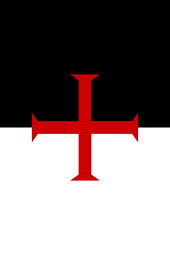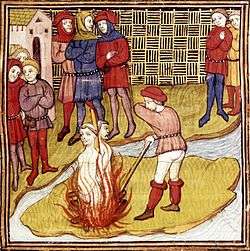Geoffroi de Charney
Geoffroi de Charney (first name sometimes spelled Geoffrey, surname sometimes spelled de Charnay and de Charny), also known as Guy d'Auvergne ("The Boy from Auvergne"), (died 11 or 18 March 1314) was Preceptor of Normandy for the Knights Templar. Charney was accepted into the Order of Knights Templar at a young age by Amaury de la Roche, the Preceptor of France. Present at the ceremony was brother Jean le Franceys, Preceptor of Pédenac. In 1307 de Charny was arrested, along with the entire Order of Knights Templar in France, and in 1314 was burned at the stake.

Persecution of the Templars
The Order of the Templars was originally created to protect the Pilgrims on the road to Jerusalem. The Templars' mission was then expanded to fight in the Crusades.
The persecution of the Templars began in France as a plan by King Philip IV, with the complicity of Pope Clement V. On October 13, 1307, the King ordered a dramatic arrest of all Templars in France. The Pope, Clement V, in November 22, 1307, under pressure from the King, also issued a papal decree, called Pastoralis praceminentiae, ordering all monarchs of the Christian faith to arrest all Templars and confiscate their lands in the name of the Pope and the Church. Though the order went out to England, Iberia, Germany, Italy and Cyprus, the leader, Templar Grand Master Jacques de Molay, Geoffrey de Charney and many other Templars were in France, and, under the orders of the French king, were arrested and severely tortured until they confessed to the series of horrible crimes of which they were accused.[2]
In 1307, the Pope sent two Cardinals to interview Jacques de Molay and Hugues de Pairaud, a Templar who is referred to as "the visitor of France", at which time they recanted their confessions and told the other Templars to do the same.[3] Two other Templars, Pierre de Bologna and Renaud de Provins also tried to convince other Templars to recant their confessions and by early May 1310, close to six hundred did so. After that Pierre de Bologna was never seen again and Renaud de Provins was sentenced to life imprisonment.
Initial charges
Geoffroi de Charney, along with the other Templars in France were arrested on October 13, 1307. Scores of charges were leveled at them; many were notably similar charges to those directed at other of Philip's enemies, such as heresy, sodomy and blasphemy.[4]
There were five initial charges lodged against the Templars. The first was the renouncement of Christ and spitting on the cross during initiation into the Order. The second was the stripping of the man to be initiated and the thrice kissing of that man by the Preceptor on the navel, posteriors and the mouth. The third was telling the neophyte (novice) that unnatural lust was lawful and indulged in commonly. The fourth was that the cord worn by the neophyte day and night was "consecrated" by wrapping it around an idol in the form of a human head with a great beard, and that this idol was adored in all chapters. The fifth was that the priests of the order did not consecrate the host in celebrating Mass. Many of these charges were made against Boniface before his capture, escape and eventual death shortly thereafter in 1308. Philip's agents pursued these charges in the name of the French King of France as they were successful in the past against other enemies of the King.[5] On August 12, 1308, the charges would be increased and would become more outrageous, such as one specifically stating that the Templars worshipped an idol made of a cat and a head, the latter having three faces. The lists of articles 86 to 127[3] would add many other charges.[6][7]
Recantation and death of Templar leaders in France

Eventually King Philip's Inquisitors succeeded in making Jacques de Molay confess to the charges.[8] On 18 March 1314, de Molay and de Charney recanted their confessions, stating they were innocent of the charges and they were only guilty of betraying their Order by confessing under duress to something they did not do. They were immediately found guilty of being relapsed heretics, for which the punishment was death. This effectively silenced the other Templars. Philip continued to pressure and threaten the Pope to officially disband the Order, and things came to a dramatic end in 1314 with the public execution by burning of leader Jacques de Molay, and Geoffroi de Charney.[3]
Death

Sadly, at this time, we know more about this man's imprisonment and death than we know of his life, except that in his imprisonment and death, he showed tremendous courage. His exact day of death is disputed by scholars. This source records his death as follows: (Note: The day varies by one day, not unusual for the chronicles of the Middle Ages): "The cardinals dallied with their duty until March 19, 1314, when, on a scaffold in front of Notre Dame, de Molay, Geoffroi de Charney, Master of Normandy, Hugues de Peraud, referred to as a visitor of France, and Godefroi de Gonneville, Master of Aquitaine, were brought forth from the jail in which for nearly seven years they had lain, to receive the sentence agreed upon by the cardinals, in conjunction with the Archbishop of Sens and some other prelates whom they had called in. Considering the offences which the culprits had confessed and confirmed, the penalty imposed was in accordance with rule—that of perpetual imprisonment. The affair was supposed to be concluded when, to the dismay of the prelates and wonderment of the assembled crowd, de Molay and Geoffroi de Charney arose. They had been guilty, they said, not of the crimes imputed to them, but of basely betraying their Order to save their own lives. It was pure and holy; the charges were fictitious and the confessions false. Hastily the cardinals delivered them to the Prevot of Paris, and retired to deliberate on this unexpected contingency, but they were saved all trouble. 'When the news was carried to Philippe he was furious. The King was furious and they were both pronounced relapsed heretics to be burned without a further hearing; the facts were notorious and no formal judgment by the papal commission need be waited for. That same day, by sunset, a pile was erected on a small island in the Seine, the Ile des Juifs, near the palace garden. There de Molay and de Charney were slowly burned to death, refusing all offers of pardon for retraction, and bearing their torment with a composure which won for them the reputation of martyrs among the people, who reverently collected their ashes as relics'.[9][10]
Legacy and the "curse"
The fact that, in little more than a month, Pope Clement V died in torment of the loathsome disease thought to be lupus, and that in eight months Philip IV of France, at the age of forty-six, was killed in an accident while hunting, necessarily gave rise to the legend that de Molay had cited them before the tribunal of God. Such stories became legend among the people, whose sense of justice had been scandalized by the whole affair. Even in distant Germany, Philippe's death was spoken of as a retribution for his destruction of the Templars, and Clement was described as shedding tears of remorse on his death-bed for three great crimes, the poisoning of Henry VII, Holy Roman Emperor and the ruin of the Templars and Beguines.[11]
Author Malcolm Barber has researched this legend and concluded that it originates from La Chronique métrique attribuée à Geffroi de Paris (ed. A. Divèrres, Strasbourg, 1956, pages 5711-5742). Geoffrey of Paris was "apparently an eye-witness, who describes Molay as showing no sign of fear and, significantly, as telling those present that God would avenge their deaths".[12][13]
This series of events forms the basis of Les Rois maudits (The Accursed Kings), a series of historical novels written by Maurice Druon between 1955 and 1977, in which Charney is a supporting character. The novels were also adapted into two French television miniseries in 1972 and 2005.
References
- Henry Charles Lea, The History of the Inquisition of the Middle Ages, Vol. 3 (NY: Harper & Bros, 1901), p. 239
- Henry Charles Lea, History of the Inquisition of the Middle Ages, vol. III, (New York: Harper & Bros, 1888), pp. 238-244
- Malcolm Barber, The Trial of the Templars (New York: Cambridge University Press, 1978), p. 2
- Henry Charles Lea, A History of the Inquisition of the Middle Ages, vol. 3 (New York: Harper & Bros, 1888), pp.250-257
- Henry Charles Lea, History of the Inquisition of the Middle Ages, vol. III, (New York: Harper & Bros, 1888), pp. 238-252
- Les Templiers, une chevalerie chrétienne au moyen-âge, Alain Demurger
- Malcolm Barber, The Trial of the Templars, (New York: Cambridge University Press 1978), pp.178,179
- Malcolm Barber, The Trial of the Templars, (New York: Cambridge University Press, 1978), p. 63
- 141.—Stemler, Contingent zur Geschichte der Tcmplcr, pp. 20-1.—Raynouard, pp. 213-4, 233-5.—Wilcke, II. 236, 240.—Anton, Vcrsuch, p. 142
- Henry Charles Lea, A History of the Inquisition of the Middle ages, vol III, (NY: Hamper & Bros, Franklin Sq. 1888), pp.324-325.
- Henry Charles Lea, A History of the Inquisition of the Middle ages, vol. III, (New York: Harper & Bros, 1888), p. 326 and his references: Raynald. ann. 1313, No. 39.—Raynouard, pp. 20.J-10.—Cbntin. Guill. Nangiac. ann. 1313.—Joann. de S.Victor. (Bouquet, XXI. 658).—Chrou. Anon. (Bouquet, XXI. 143).—Godefroy de Paris v. G033-6129.—Villani Cbron. viii. 92.— hron. CorneL Zantfliet ann. 1310 (Martene Ampl, Coll. V. 160).— Trithem. Chron. Hirsaug. ann. 1307.—Pauli ^mylii de Reb. Gcst. Franc. Ed. 1509, p. 326
- Malcolm Barber, The Trial of The Templars,(Cambridge University Press, 2006) p. 357, footnote 110, Second edition . ISBN 0-521-67236-8
- In The New Knighthood Barber referred to a variant of this legend, about how an unspecifed Templar had appeared before and denounced Clement V and, when he was about to be executed sometime later, warned that both Pope and King would "within a year and a day be obliged to explain their crimes in the presence of God", found in the work by Ferretto of Vicenza, Historia rerum in Italia gestarum ab anno 1250 ad annum usque 1318 (Malcolm Barber, The New Knighthood, pp. 314-315 (Cambridge University Press, 1994). ISBN 0-521-55872-7